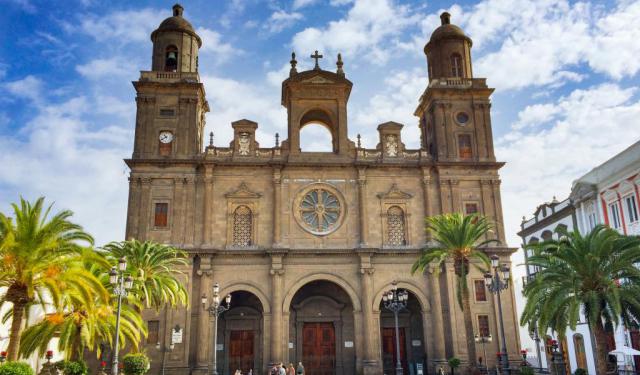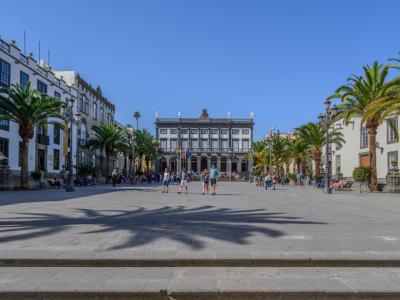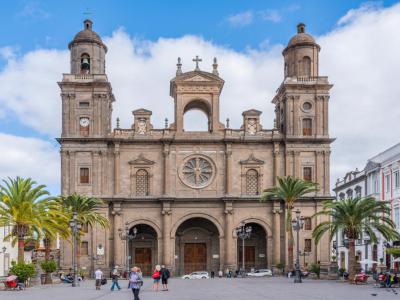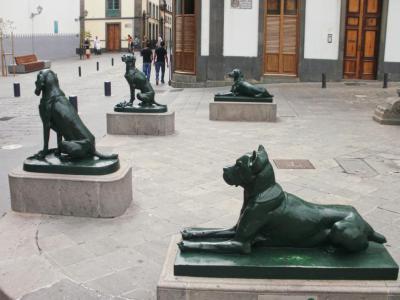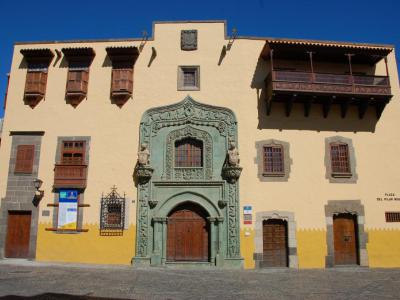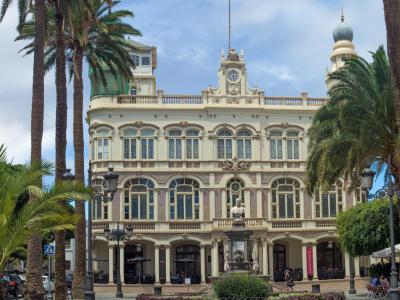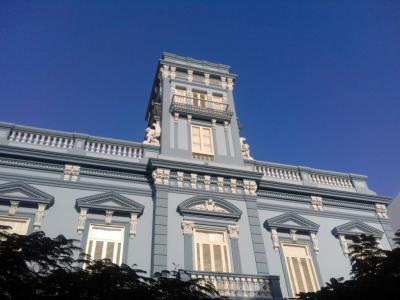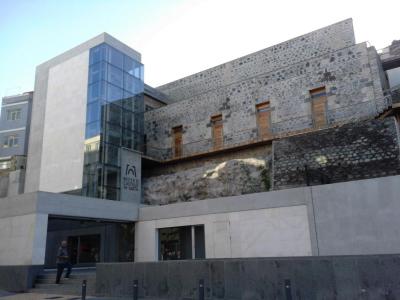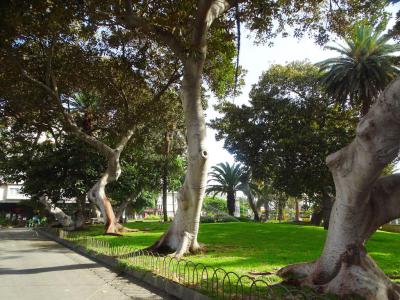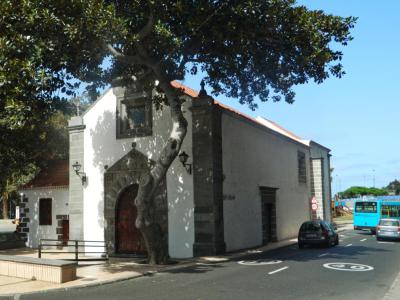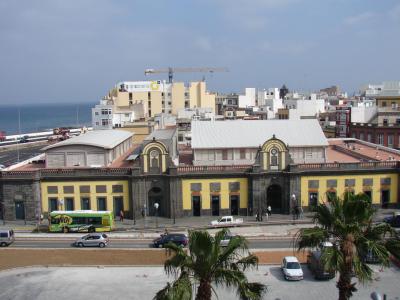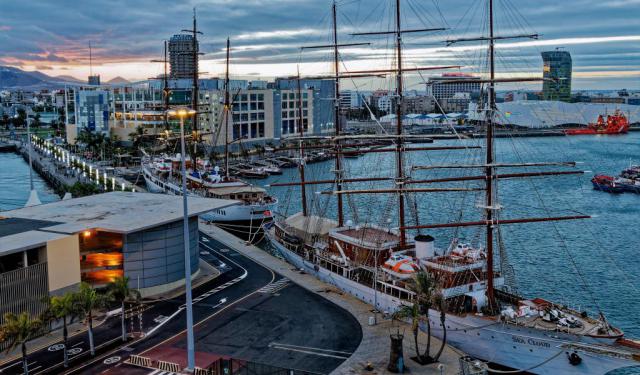Las Palmas de Gran Canaria Introduction Walking Tour (Self Guided), Las Palmas de Gran Canaria
Situated along the rugged coast of Grand Canary Island, Las Palmas de Gran Canaria boasts a myriad of attractions. In addition to its unique urban beaches, numerous hotels, dining establishments, and recreational areas, Las Palmas offers a historic old town brimming with heritage, tracing back to the 15th century when Spanish explorers first set foot on these shores.
The city was founded in 1478 and was initially named "Real de Las Palmas" (Royal of The Palms) in homage to the abundance of palm trees that once graced its landscapes. Its tumultuous beginning was marked by conflict between the invading Castilian (Spanish) forces and the local inhabitants. The five-year struggle, culminating in 1483, resulted in the island's incorporation into the Crown of Castile, despite fierce resistance from the indigenous population.
Notable historical events that followed included Christopher Columbus's stopover in 1492 – the Colón House in which he stayed is now a museum. There were also several attempts to plunder the town by foreign raiders. In 1595, English privateer Francis Drake tried an invasion that led to the Battle of Las Palmas, and in 1599, a Dutch raid under Vice-Admiral Pieter van der Does saw some of the town destroyed but was ultimately repelled.
Throughout the 16th and 17th centuries, Las Palmas flourished as a strategic waypoint for voyages between Europe, Africa, and the Americas. It also grew in importance, serving as the residence of the Captains General of the Canary Islands. The construction of the La Luz port in 1883 propelled the city's modernization and economic development. In 1927, Las Palmas de Gran Canaria was designated as the capital of the newly formed Las Palmas province, solidifying its status as a key administrative center in the Canary Islands.
Delving into local sights, one should keep an eye open for the must-see spots like the majestic Santa Ana Cathedral towering over the bustling Plaza Mayor de Santa Ana. Nearby, the sculptured dogs of Santa Ana add a whimsical touch to the historic surroundings.
Venturing along the picturesque Triana Main Street (Calle Mayor de Triana), one encounters a tapestry of shops, cafes, and historic landmarks, culminating in the vibrant Vegueta Market, where the flavors and aromas of the Canary Islands come to life.
As you immerse yourself in the charm of this city, let its storied streets inspire you to embark on your own journey of discovery. Our self-guided tour invites you to explore, experience, and embrace all that Las Palmas de Gran Canaria has to offer.
The city was founded in 1478 and was initially named "Real de Las Palmas" (Royal of The Palms) in homage to the abundance of palm trees that once graced its landscapes. Its tumultuous beginning was marked by conflict between the invading Castilian (Spanish) forces and the local inhabitants. The five-year struggle, culminating in 1483, resulted in the island's incorporation into the Crown of Castile, despite fierce resistance from the indigenous population.
Notable historical events that followed included Christopher Columbus's stopover in 1492 – the Colón House in which he stayed is now a museum. There were also several attempts to plunder the town by foreign raiders. In 1595, English privateer Francis Drake tried an invasion that led to the Battle of Las Palmas, and in 1599, a Dutch raid under Vice-Admiral Pieter van der Does saw some of the town destroyed but was ultimately repelled.
Throughout the 16th and 17th centuries, Las Palmas flourished as a strategic waypoint for voyages between Europe, Africa, and the Americas. It also grew in importance, serving as the residence of the Captains General of the Canary Islands. The construction of the La Luz port in 1883 propelled the city's modernization and economic development. In 1927, Las Palmas de Gran Canaria was designated as the capital of the newly formed Las Palmas province, solidifying its status as a key administrative center in the Canary Islands.
Delving into local sights, one should keep an eye open for the must-see spots like the majestic Santa Ana Cathedral towering over the bustling Plaza Mayor de Santa Ana. Nearby, the sculptured dogs of Santa Ana add a whimsical touch to the historic surroundings.
Venturing along the picturesque Triana Main Street (Calle Mayor de Triana), one encounters a tapestry of shops, cafes, and historic landmarks, culminating in the vibrant Vegueta Market, where the flavors and aromas of the Canary Islands come to life.
As you immerse yourself in the charm of this city, let its storied streets inspire you to embark on your own journey of discovery. Our self-guided tour invites you to explore, experience, and embrace all that Las Palmas de Gran Canaria has to offer.
How it works: Download the app "GPSmyCity: Walks in 1K+ Cities" from Apple App Store or Google Play Store to your mobile phone or tablet. The app turns your mobile device into a personal tour guide and its built-in GPS navigation functions guide you from one tour stop to next. The app works offline, so no data plan is needed when traveling abroad.
Las Palmas de Gran Canaria Introduction Walking Tour Map
Guide Name: Las Palmas de Gran Canaria Introduction Walking Tour
Guide Location: Spain » Las Palmas de Gran Canaria (See other walking tours in Las Palmas de Gran Canaria)
Guide Type: Self-guided Walking Tour (Sightseeing)
# of Attractions: 12
Tour Duration: 2 Hour(s)
Travel Distance: 3.0 Km or 1.9 Miles
Author: DanaOffice
Sight(s) Featured in This Guide:
Guide Location: Spain » Las Palmas de Gran Canaria (See other walking tours in Las Palmas de Gran Canaria)
Guide Type: Self-guided Walking Tour (Sightseeing)
# of Attractions: 12
Tour Duration: 2 Hour(s)
Travel Distance: 3.0 Km or 1.9 Miles
Author: DanaOffice
Sight(s) Featured in This Guide:
- Plaza Mayor de Santa Ana (Main Square of Santa Ana)
- Catedral de Santa Ana (Cathedral of Saint Anne)
- Los Perros de La Plaza de Santa Ana (The Dogs of Santa Ana Square)
- Plaza del Pilar Nuevo (New Pillar Square)
- Casa de Colon (Columbus House)
- Gabinete Literario (Literary Cabinet)
- Palacete Rodriguez Quegles (Rodriguez Quegles Mansion)
- Museo Castillo de Mata (Castle of Mata Museum)
- Parque de San Telmo (San Telmo Park)
- Ermita de San Telmo (Hermitage of San Telmo)
- Calle Mayor de Triana (Main Street of Triana)
- Mercado de Vegueta (Vegueta Market)
1) Plaza Mayor de Santa Ana (Main Square of Santa Ana) (must see)
The Plaza Mayor de Santa Ana stands as an iconic symbol in Las Palmas de Gran Canaria, nestled within the historic Vegueta neighborhood alongside the renowned Cathedral. Named after the Patroness of the City, the plaza serves as a focal point of the city's rich history and cultural heritage. Its significance dates back to the early urbanization efforts undertaken by the island's conquerors, who selected this area as the nucleus of one of the first settlements in the Canary Islands.
Surrounded by notable landmarks such as the City Council Houses, the Bishop's Palace, and the Cathedral itself, the Plaza Mayor de Santa Ana exudes a timeless charm and architectural splendor. The nearby Patio de los Naranjos of the Cathedral houses the Diocesan Museum of Sacred Art, adding to the plaza's allure as a cultural hub. Adjacent to the square lies the Regental Palace, serving as the residence of the president of the Territorial Court, further enhancing the area's historical significance and administrative prominence.
One of the most distinctive features of the Plaza Mayor de Santa Ana is the sculptural group known as the "Dogs of the Plaza de Santa Ana." Comprising eight cast iron sculptures, these canine figures adorn one end of the square, facing the cathedral's façade. Although their exact origins remain shrouded in mystery, these sculptures, painted green to resemble bronze, were installed in 1895 and have since become iconic symbols of the city. Their presence adds a unique charm to the plaza, inviting visitors to explore its historic surroundings and immerse themselves in the rich tapestry of Las Palmas de Gran Canaria's heritage.
Surrounded by notable landmarks such as the City Council Houses, the Bishop's Palace, and the Cathedral itself, the Plaza Mayor de Santa Ana exudes a timeless charm and architectural splendor. The nearby Patio de los Naranjos of the Cathedral houses the Diocesan Museum of Sacred Art, adding to the plaza's allure as a cultural hub. Adjacent to the square lies the Regental Palace, serving as the residence of the president of the Territorial Court, further enhancing the area's historical significance and administrative prominence.
One of the most distinctive features of the Plaza Mayor de Santa Ana is the sculptural group known as the "Dogs of the Plaza de Santa Ana." Comprising eight cast iron sculptures, these canine figures adorn one end of the square, facing the cathedral's façade. Although their exact origins remain shrouded in mystery, these sculptures, painted green to resemble bronze, were installed in 1895 and have since become iconic symbols of the city. Their presence adds a unique charm to the plaza, inviting visitors to explore its historic surroundings and immerse themselves in the rich tapestry of Las Palmas de Gran Canaria's heritage.
2) Catedral de Santa Ana (Cathedral of Saint Anne) (must see)
The Cathedral of Santa Ana is also known as the Holy Cathedral-Basilica of the Canary Islands. The cathedral's dedication is celebrated annually on November 26th. Renowned as the most important monument of Canarian religious architecture, its construction showcases the distinctive Gothic Pointed architectural style.
The cathedral's design features a nave with double aisles, pseudo-transepts with eastern aisles, and a sanctuary. The nave and aisles extend westward of the cross, with primary aisles reaching the same height as the nave and secondary aisles utilized for chapels. Intricately crafted piers mimic the appearance of palm trees, supporting octagonal columns adorned with classicizing mouldings. These columns, exhibiting a fusion of Corinthian and Pointed styles, are embellished with richly detailed bands, including cable motifs, rows of ball-flowers, and chevron patterns.
The architectural marvel continues with pointed arches between the aisles and responds adorned with foliaged heads. The vaulting, characterized by its excellent sexpartite design, adds to the cathedral's grandeur. While much of the structure reflects the masterful craftsmanship of its original design, some elements remained unfinished in the sixteenth century.
The cathedral's design features a nave with double aisles, pseudo-transepts with eastern aisles, and a sanctuary. The nave and aisles extend westward of the cross, with primary aisles reaching the same height as the nave and secondary aisles utilized for chapels. Intricately crafted piers mimic the appearance of palm trees, supporting octagonal columns adorned with classicizing mouldings. These columns, exhibiting a fusion of Corinthian and Pointed styles, are embellished with richly detailed bands, including cable motifs, rows of ball-flowers, and chevron patterns.
The architectural marvel continues with pointed arches between the aisles and responds adorned with foliaged heads. The vaulting, characterized by its excellent sexpartite design, adds to the cathedral's grandeur. While much of the structure reflects the masterful craftsmanship of its original design, some elements remained unfinished in the sixteenth century.
3) Los Perros de La Plaza de Santa Ana (The Dogs of Santa Ana Square)
"The Dogs of Santa Ana Square" are iconic sculptures that adorn the historic Plaza de Santa An. Crafted from cast iron by the French sculptor Alfred Jacquemar in 1895, these sculptures have become enduring symbols of the city's cultural heritage. Jacquemar's initials, "AJ," can still be seen on the sculptures, adding to their historical significance.
The origins of these sculptures are steeped in intriguing lore and legend. One account suggests that Mayor Felipe Massieu accepted them as a gift from a French ship that made a stop in Las Palmas while en route to South Africa. Grateful for the city's assistance with certain issues encountered during its journey, the ship left behind these statues, which were originally intended to adorn urban centers in Africa. Another hypothesis proposes that the dogs were donated by James, one of the sons of Thomas Miller, a prominent British businessman in Gran Canaria.
In a traditional fable titled "Faycán," penned by writer Víctor Doreste in 1944, these unique sculptures were given names and characters. Alongside the protagonist, Faycán, a Canarian breed dog reflecting on its life, Doreste named seven other dogs represented by the sculptures in Santa Ana Square. These names include Aterura, Mogano, Doramas, Tindaya, Bentayga, Tenoya, and Tirajano.
The origins of these sculptures are steeped in intriguing lore and legend. One account suggests that Mayor Felipe Massieu accepted them as a gift from a French ship that made a stop in Las Palmas while en route to South Africa. Grateful for the city's assistance with certain issues encountered during its journey, the ship left behind these statues, which were originally intended to adorn urban centers in Africa. Another hypothesis proposes that the dogs were donated by James, one of the sons of Thomas Miller, a prominent British businessman in Gran Canaria.
In a traditional fable titled "Faycán," penned by writer Víctor Doreste in 1944, these unique sculptures were given names and characters. Alongside the protagonist, Faycán, a Canarian breed dog reflecting on its life, Doreste named seven other dogs represented by the sculptures in Santa Ana Square. These names include Aterura, Mogano, Doramas, Tindaya, Bentayga, Tenoya, and Tirajano.
4) Plaza del Pilar Nuevo (New Pillar Square)
New Pillar Square is a historic square steeped in charm and significance within Las Palmas de Gran Canaria. Originally serving as a central gathering point for women who collected water from the central pillar, the square retains its authentic character and cultural allure. At the heart of the plaza stands a captivating stone fountain, reminiscent of bygone eras and serving as a focal point for community engagement.
The New Pillar Square exudes a timeless ambiance, surrounded by buildings of various architectural styles and periods. Among these structures, the Casa de Colón stands out with its verdant façade, an architectural gem that captivates the imagination of all who behold it. This extraordinary building adds to the allure of the square, enriching its cultural significance and inviting exploration and discovery.
This square's cobblestone surface and charming surroundings evoke a sense of nostalgia, offering visitors a glimpse into the island's rich heritage. On Sundays, the New Pillar Square comes alive with the bustling activity of the Crafts and Culture Market, where artisans showcase their creations and locals and tourists alike gather to immerse themselves in the vibrant atmosphere. Adjacent to the square, a monument pays tribute to the renowned Canarian composer Néstor Álamo, adding a touch of artistic flair to this enchanting enclave.
The New Pillar Square exudes a timeless ambiance, surrounded by buildings of various architectural styles and periods. Among these structures, the Casa de Colón stands out with its verdant façade, an architectural gem that captivates the imagination of all who behold it. This extraordinary building adds to the allure of the square, enriching its cultural significance and inviting exploration and discovery.
This square's cobblestone surface and charming surroundings evoke a sense of nostalgia, offering visitors a glimpse into the island's rich heritage. On Sundays, the New Pillar Square comes alive with the bustling activity of the Crafts and Culture Market, where artisans showcase their creations and locals and tourists alike gather to immerse themselves in the vibrant atmosphere. Adjacent to the square, a monument pays tribute to the renowned Canarian composer Néstor Álamo, adding a touch of artistic flair to this enchanting enclave.
5) Casa de Colon (Columbus House)
Built on the site of the former residence of the Island’s Governor, the Columbus House holds a pivotal place in the city's heritage. In 1492, just fourteen years after the city's foundation, Christopher Columbus made his first stop in Gran Canaria, a momentous event that is commemorated within the walls of this iconic museum. Columbus returned to the island on subsequent voyages, further cementing its place in maritime history.
The museum itself is a treasure trove of exhibits and artifacts that bring Columbus' voyages to life. Magnificent patios and exhibition halls invite visitors to delve into the explorer's travels, his interactions with the Canary Islands, and the historical connections between the archipelago and the Americas. Through immersive displays, visitors can explore the history of Las Palmas de Gran Canaria, learn about pre-Columbian America, and marvel at the museum's impressive art collection.
Constructed in traditional Canary architecture, the current building underwent refurbishment by the Cabildo de Gran Canaria in 1951. While preserving its original features, the renovation also included the reconstruction of certain elements, ensuring that the Casa de Colón stands as a beacon of cultural heritage and a symbol of Las Palmas de Gran Canaria's enduring ties to the Age of Exploration.
The museum itself is a treasure trove of exhibits and artifacts that bring Columbus' voyages to life. Magnificent patios and exhibition halls invite visitors to delve into the explorer's travels, his interactions with the Canary Islands, and the historical connections between the archipelago and the Americas. Through immersive displays, visitors can explore the history of Las Palmas de Gran Canaria, learn about pre-Columbian America, and marvel at the museum's impressive art collection.
Constructed in traditional Canary architecture, the current building underwent refurbishment by the Cabildo de Gran Canaria in 1951. While preserving its original features, the renovation also included the reconstruction of certain elements, ensuring that the Casa de Colón stands as a beacon of cultural heritage and a symbol of Las Palmas de Gran Canaria's enduring ties to the Age of Exploration.
6) Gabinete Literario (Literary Cabinet)
The Literary Cabinet, established in 1844, stands as a cherished historical landmark in Las Palmas de Gran Canaria, revered as a national monument. Originally conceived as the island's inaugural theater, this ornate edifice exudes an aura of faded elegance, preserving the grandeur of a bygone era. Its architectural splendor is evident in every corner, from the intricate detailing of its façade to the gracious internal patio adorned with a splendid atrium.
Despite its transformation over the years, the Literary Cabinet retains its storied charm, offering visitors a glimpse into the cultural heritage of Las Palmas. The interior spaces are adorned with rows of bookcases, lending an air of intellectual sophistication to the ambiance. While the building now operates as a private club, it remains accessible to the public, inviting all to partake in its timeless allure.
One of the highlights of the Literary Cabinet is its fancy terrace restaurant, which beckons guests to indulge in culinary delights amidst the opulent surroundings. With seating available outdoors, visitors can savor delectable dishes while basking in the warm Canarian sun. Additionally, the lobby area invites exploration, allowing visitors to immerse themselves in the rich history and cultural significance of this iconic institution.
Despite its transformation over the years, the Literary Cabinet retains its storied charm, offering visitors a glimpse into the cultural heritage of Las Palmas. The interior spaces are adorned with rows of bookcases, lending an air of intellectual sophistication to the ambiance. While the building now operates as a private club, it remains accessible to the public, inviting all to partake in its timeless allure.
One of the highlights of the Literary Cabinet is its fancy terrace restaurant, which beckons guests to indulge in culinary delights amidst the opulent surroundings. With seating available outdoors, visitors can savor delectable dishes while basking in the warm Canarian sun. Additionally, the lobby area invites exploration, allowing visitors to immerse themselves in the rich history and cultural significance of this iconic institution.
7) Palacete Rodriguez Quegles (Rodriguez Quegles Mansion)
The Rodriguez Quegles Mansion stands as a testament to the opulence and grandeur of a bygone era. Constructed circa 1901, this magnificent mansion served as a lavish residence for Juan Rodríguez Quegles, a prominent businessman and president of the Mercantile Society. Born in Fuerteventura, Rodríguez Quegles relocated to Gran Canaria, where he embarked on a successful career, amassing wealth and influence in the process.
Designed in the modernist style by architect Mariano Belmás Estrada and executed by Fernando Navarro y Navarro, the Palacete Rodríguez Quegles epitomizes the eclectic tastes of the bourgeois class of the early 20th century. The mansion's architecture and decorative elements reflect a fusion of diverse influences, showcasing a harmonious blend of foreign styles characteristic of the period. From ornate facades to intricate detailing, every aspect of the Palacete exudes an air of sophistication and refinement.
Originally envisioned as a token of love for Rodríguez Quegles' wife, María Teresa González Díaz, the Palacete Rodríguez Quegles was intended to be the most beautiful house in the city. Its construction marked a significant milestone in the architectural landscape of Las Palmas, earning it a prominent place among the city's architectural treasures. Today, the mansion has been meticulously restored and repurposed as a cultural center, serving as an exhibition space and hub for coordinating various cultural activities under the auspices of the CreActiva project initiated by the City Council.
Designed in the modernist style by architect Mariano Belmás Estrada and executed by Fernando Navarro y Navarro, the Palacete Rodríguez Quegles epitomizes the eclectic tastes of the bourgeois class of the early 20th century. The mansion's architecture and decorative elements reflect a fusion of diverse influences, showcasing a harmonious blend of foreign styles characteristic of the period. From ornate facades to intricate detailing, every aspect of the Palacete exudes an air of sophistication and refinement.
Originally envisioned as a token of love for Rodríguez Quegles' wife, María Teresa González Díaz, the Palacete Rodríguez Quegles was intended to be the most beautiful house in the city. Its construction marked a significant milestone in the architectural landscape of Las Palmas, earning it a prominent place among the city's architectural treasures. Today, the mansion has been meticulously restored and repurposed as a cultural center, serving as an exhibition space and hub for coordinating various cultural activities under the auspices of the CreActiva project initiated by the City Council.
8) Museo Castillo de Mata (Castle of Mata Museum)
The Castle of Mata Museum is a historical fortress-turned-museum that tells the story of the island’s military past and urban evolution. Originally built in the 16th century as part of the city's defense system against pirate attacks, the castle has seen multiple reconstructions over the centuries.
Today, it serves as a cultural space showcasing exhibits on the history of Gran Canaria, its fortifications, and the broader maritime conflicts that shaped the island. The museum blends historic architecture with modern exhibition spaces, offering visitors an insightful journey through the strategic role of Las Palmas in the Atlantic.
Today, it serves as a cultural space showcasing exhibits on the history of Gran Canaria, its fortifications, and the broader maritime conflicts that shaped the island. The museum blends historic architecture with modern exhibition spaces, offering visitors an insightful journey through the strategic role of Las Palmas in the Atlantic.
9) Parque de San Telmo (San Telmo Park)
Steeped in history, the iconic San Telmo Park occupies a significant place in the city's origins, once serving as the site of its northern wall and boasting the distinction of being the location of the first dock in a city poised to embrace the wider world. Today, it remains a cherished green oasis amidst the bustling urban landscape, offering respite and recreation to locals and visitors alike.
Amidst the lush foliage of San Telmo Park, visitors will discover a treasure trove of architectural gems and cultural landmarks. The Modernist Quisco, designed by Rafael Massanet y Faus in 1923, now serves as an inviting open-air cafeteria, inviting patrons to relax and enjoy the serene surroundings. The park's bandstand provides a regular venue for performances by the Municipal Music Band, adding a melodious touch to the ambiance. Meanwhile, the 18th-century Hermitage of San Telmo boasts a stunning altarpiece, offering visitors a glimpse into the island's rich religious heritage.
San Telmo Park is not only a place of natural beauty but also a hub of social and cultural activity throughout the year. Families flock to its expansive children's play area, where laughter and joy abound, while the park plays host to a variety of events that bring the community together. For pet owners, a specially adapted dog park provides a safe and enjoyable space for furry companions to frolic. With ample seating and shaded areas, San Telmo Park invites visitors to linger and soak in the tranquil atmosphere, making it a beloved destination for locals and tourists seeking a moment of relaxation amidst the vibrant energy of Las Palmas de Gran Canaria.
Amidst the lush foliage of San Telmo Park, visitors will discover a treasure trove of architectural gems and cultural landmarks. The Modernist Quisco, designed by Rafael Massanet y Faus in 1923, now serves as an inviting open-air cafeteria, inviting patrons to relax and enjoy the serene surroundings. The park's bandstand provides a regular venue for performances by the Municipal Music Band, adding a melodious touch to the ambiance. Meanwhile, the 18th-century Hermitage of San Telmo boasts a stunning altarpiece, offering visitors a glimpse into the island's rich religious heritage.
San Telmo Park is not only a place of natural beauty but also a hub of social and cultural activity throughout the year. Families flock to its expansive children's play area, where laughter and joy abound, while the park plays host to a variety of events that bring the community together. For pet owners, a specially adapted dog park provides a safe and enjoyable space for furry companions to frolic. With ample seating and shaded areas, San Telmo Park invites visitors to linger and soak in the tranquil atmosphere, making it a beloved destination for locals and tourists seeking a moment of relaxation amidst the vibrant energy of Las Palmas de Gran Canaria.
10) Ermita de San Telmo (Hermitage of San Telmo)
The Hermitage of San Telmo, boasting one of the most exquisite altarpieces on the island of Gran Canaria, stands as a remarkable example of Mudejar architecture adorned with a Gothic-Renaissance facade. Its origins trace back to the 16th century when the first hermitage dedicated to San Pedro González Telmo was established. However, in 1599, the hermitage fell victim to the devastating attack led by the privateer Pieter van der Does and was subsequently destroyed. Reconstruction efforts commenced in 1604, giving rise to the present-day structure that continues to captivate visitors with its historical significance and architectural splendor.
Throughout its storied history, the Hermitage of San Telmo has served as a place of prayer and a central hub for the brotherhood of the seafarers' or sailors' guild. Additionally, it has functioned as a burial site, preserving the memory of those who once frequented its sacred halls. Today, the hermitage has been repurposed as the parish church of San Bernardo and holds the esteemed designation of being declared an Asset of Cultural Interest, underscoring its importance as a cultural and historical landmark in Las Palmas de Gran Canaria.
The architectural layout of the Hermitage of San Telmo is characterized by a rectangular plan featuring two longitudinal bays. The larger bay encompasses the nave of the church, covered by a dual-pitched roof, while the presbytery, distinguished by its taller stature, boasts a triple-pitched roof. Notable architectural elements within the hermitage include the intricately decorated fajón arch and the Mudejar coffered ceilings, both of which exemplify the exquisite craftsmanship of the era. Moreover, visitors are treated to the sight of the Baroque-style main altarpiece and the vibrant polychrome panels that adorn the interior, each contributing to the hermitage's undeniable allure and historical significance.
Throughout its storied history, the Hermitage of San Telmo has served as a place of prayer and a central hub for the brotherhood of the seafarers' or sailors' guild. Additionally, it has functioned as a burial site, preserving the memory of those who once frequented its sacred halls. Today, the hermitage has been repurposed as the parish church of San Bernardo and holds the esteemed designation of being declared an Asset of Cultural Interest, underscoring its importance as a cultural and historical landmark in Las Palmas de Gran Canaria.
The architectural layout of the Hermitage of San Telmo is characterized by a rectangular plan featuring two longitudinal bays. The larger bay encompasses the nave of the church, covered by a dual-pitched roof, while the presbytery, distinguished by its taller stature, boasts a triple-pitched roof. Notable architectural elements within the hermitage include the intricately decorated fajón arch and the Mudejar coffered ceilings, both of which exemplify the exquisite craftsmanship of the era. Moreover, visitors are treated to the sight of the Baroque-style main altarpiece and the vibrant polychrome panels that adorn the interior, each contributing to the hermitage's undeniable allure and historical significance.
11) Calle Mayor de Triana (Main Street of Triana) (must see)
Main Street of Triana stands as the principal thoroughfare of the Triana neighborhood. It reigns as one of the city's foremost commercial hubs, pulsating with the energy of bustling shops, restaurants, and cultural attractions. The street's rich tapestry of history and urban development traces back to its humble beginnings at the Guiniguada ravine, where the Puente de Palo once bridged the divide between Triana and the Vegueta neighborhood. From this point, Main Street of Triana stretches parallel to the coastline, leading to the picturesque San Telmo Park, marking the erstwhile boundary of the city's urban core in the 19th century.
Throughout the 19th century, Triana underwent a period of architectural evolution, spurred by the socioeconomic aspirations of the burgeoning bourgeoisie. The dissolution of convents and subsequent privatization of their properties catalyzed the creation of new streets, squares, and residential edifices, including the iconic Calle Mayor. Notable landmarks such as the Military Government building and the Pérez Galdós Theater emerged at opposite ends of the neighborhood, leaving an indelible imprint on the urban fabric of Triana.
As the 20th century dawned, the architectural landscape of Main Street of Triana experienced a metamorphosis, characterized by the emergence of modernist and rationalist influences. Affluent families undertook extensive renovations, adorning their homes with ornate facades that served as a testament to their social stature. Meanwhile, monumental structures like the Island Council of Gran Canaria headquarters, designed by architect Miguel Martín-Fernández de la Torre, added a touch of grandeur to the streetscape, symbolizing the neighborhood's embrace of technological and industrial progress.
Throughout the 19th century, Triana underwent a period of architectural evolution, spurred by the socioeconomic aspirations of the burgeoning bourgeoisie. The dissolution of convents and subsequent privatization of their properties catalyzed the creation of new streets, squares, and residential edifices, including the iconic Calle Mayor. Notable landmarks such as the Military Government building and the Pérez Galdós Theater emerged at opposite ends of the neighborhood, leaving an indelible imprint on the urban fabric of Triana.
As the 20th century dawned, the architectural landscape of Main Street of Triana experienced a metamorphosis, characterized by the emergence of modernist and rationalist influences. Affluent families undertook extensive renovations, adorning their homes with ornate facades that served as a testament to their social stature. Meanwhile, monumental structures like the Island Council of Gran Canaria headquarters, designed by architect Miguel Martín-Fernández de la Torre, added a touch of grandeur to the streetscape, symbolizing the neighborhood's embrace of technological and industrial progress.
12) Mercado de Vegueta (Vegueta Market)
The Vegueta Market stands as a haven for culinary enthusiasts and lovers of fresh, local produce. Unlike traditional markets that offer a wide array of items, Vegueta Market focuses exclusively on offering an abundant selection of local foods and products, making it a culinary paradise for visitors eager to explore the gastronomic treasures of Gran Canaria and beyond. From vibrant fruits and vegetables to aromatic spices, herbs, cheeses, eggs, meats, and fish, the market showcases the diverse bounty of the Canary Islands and other regions of Spain.
As visitors meander through the market's bustling aisles, they are greeted by a kaleidoscope of colors, scents, and flavors, tantalizing the senses and igniting a culinary journey of discovery. Whether seeking the perfect ingredients for a traditional Canarian dish or craving exotic delicacies from the nearby coasts of West Africa, the Mercado de Vegueta offers an unparalleled selection of fresh, high-quality products sourced directly from local producers and fishermen.
One cannot help but be drawn to the market's vibrant stalls teeming with an abundance of fruits and vegetables, each displaying the rich diversity of the island's agricultural heritage. From succulent Canary Islands bananas to juicy tropical fruits and crisp, seasonal vegetables, there is no shortage of culinary delights to tantalize the taste buds. Additionally, visitors can indulge in freshly prepared cut fruit and natural juices, perfect for a refreshing and healthy treat during their exploration of Las Palmas de Gran Canaria.
As visitors meander through the market's bustling aisles, they are greeted by a kaleidoscope of colors, scents, and flavors, tantalizing the senses and igniting a culinary journey of discovery. Whether seeking the perfect ingredients for a traditional Canarian dish or craving exotic delicacies from the nearby coasts of West Africa, the Mercado de Vegueta offers an unparalleled selection of fresh, high-quality products sourced directly from local producers and fishermen.
One cannot help but be drawn to the market's vibrant stalls teeming with an abundance of fruits and vegetables, each displaying the rich diversity of the island's agricultural heritage. From succulent Canary Islands bananas to juicy tropical fruits and crisp, seasonal vegetables, there is no shortage of culinary delights to tantalize the taste buds. Additionally, visitors can indulge in freshly prepared cut fruit and natural juices, perfect for a refreshing and healthy treat during their exploration of Las Palmas de Gran Canaria.
Walking Tours in Las Palmas de Gran Canaria, Spain
Create Your Own Walk in Las Palmas de Gran Canaria
Creating your own self-guided walk in Las Palmas de Gran Canaria is easy and fun. Choose the city attractions that you want to see and a walk route map will be created just for you. You can even set your hotel as the start point of the walk.
Las Palmas Port Area Walk
A pivotal point for maritime traffic between Europe, Africa, and America, La Luz Port constitutes one of Spain's principal ports and holds the distinction of being the foremost port in the West African geographical zone. Situated approximately five kilometers away from the city center of Las Palmas de Gran Canaria, it presents a diverse range of attractions to explore.
One prominent... view more
Tour Duration: 1 Hour(s)
Travel Distance: 2.8 Km or 1.7 Miles
One prominent... view more
Tour Duration: 1 Hour(s)
Travel Distance: 2.8 Km or 1.7 Miles
The Most Popular Cities
/ view all
